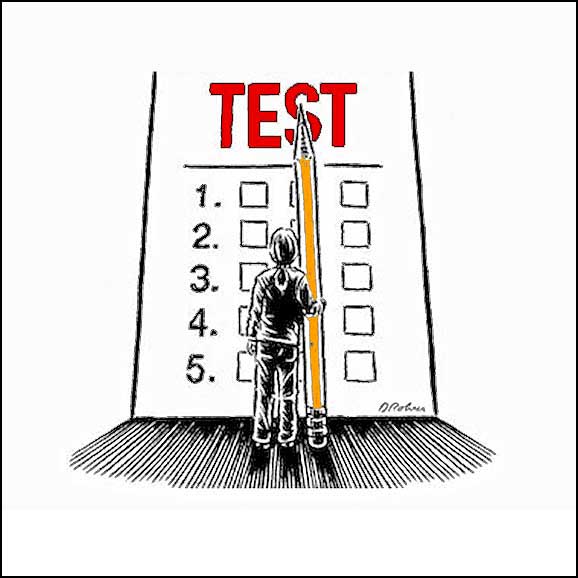Testing, testing, testing.
What Exactly do They Inform us About Actual Students’ Abilities?
Standardized testing plays a momentous role in our Nation’s education. The goal of these assessments is to provide a measure to evaluate student performance across state, national and even global standards. However, does our far-reaching focus on standardized test scores actually meet this lofty educational goal?
Unless living underneath a rock, we are all familiar with both the proponents and the opponents when it comes to standardized testing. This modern educational practice has ignited a national debate about the effectiveness of testing and how well they truly measure student achievement.
Low scores can prevent a student from advancing to the next grade level, from getting into their preferred high school or it might even lead to school closings.
Meanwhile, high test scores factor into continued federal funding for public schools being held to the highest standards of accountability. Private schools, on the other hand, are not held to the same rigorous testing standards.
Proponents say these tests measure student achievement, ensure teachers and schools are accountable to taxpayers and provide consistency to our students.

Who is Actually Benefitting From It?
Opponents say these tests promote a “teaching to the test” curriculum, undermine critical thinking and are not the best evidence of student performance.
Worst of all, most students tend to feel a great deal of pressure over doing their best on standardized assessments. Over more than a decade, I’ve seen many tears shed over the fear of a bad performance. And these tears start at young ages – in my district we go so far as to plug in and to ‘assess’ our kindergarten students. That’s five years old.
I question how much our society is truly invested in education and the development of our students. Politicians seem quick to turn children into political pawns and then to ignore the unintended consequences.
Timed tests add even more pressure and seem to punish children having a slower processing speed than their peers. In some cases (more often than many may realize) this pressure results in test fatigue, negative thinking, anxiety disorders and even low self-esteem.
As an educator I often wonder, is our extreme modern day test culture truly in the best interest of our children?
The History of Standardized Testing
Standardized testing has been around for a very long time. Earliest evidence points to Imperial China, where standardized testing used to be used in a rudimentary form to determine one’s eligibility for positions in the government of the ruling class.
In the early 1900s, Alfred Binet developed the Stanford-Binet Intelligence Test, which later became what we know as the IQ test. Throughout World War I, the military used Army Mental Tests to determine the best positions for new recruits. And in 1936, IBM developed a system of automating test scores by scanning bubbled-in answers.
The Scholastic Assessment Test (SAT) was first introduced by the College Board in 1926. It contained 315 questions covering areas like vocabulary, analogies, and math proficiency. Students are still being tested in these areas today.
The 2000s ushered in even more high stakes testing. The No Child Left Behind Act and the Common Core State Standards Initiative are prominent examples of test-based and computerized accountability policies. We have invested lots of taxpayer dollars into such mandated tests.
Students are tested more now than ever before.
Consider for a moment what was required of fourth grade students at the public school I was teaching at in the year 2019. I say public school specifically because Wisconsin’s 2011 Act 10 Law exempted private schools from most of these testing requirements.
That year, our fourth graders completed 3 official rounds (in addition to the mandated monthly practice rounds) of a district-wide benchmark assessment in both reading and math.
Based on their fall scores, the district determined certain students to have tested below proficiency at their grade levels in either or both of these subjects. Those not considered proficient by the district were then subjected to more diagnostic testing in Reading and Math.
Students were diagnostically tested again in January and once again in May. These diagnostic tests can take up to 90 minutes per test! All of this testing is done in the form of computerized screen time. Interventions were also assigned. Many also in the form of daily screen time.
Next, our 4th graders went through more than 5 hours of testing via the Wisconsin Forward Exam throughout the spring months. In addition to reading and math, fourth graders are also mandated by the state of Wisconsin to test in Writing, Science, and Social Studies. All of this equates to many more hours of a child’s learning and exploration time spent instead on test preparation and on standardized computer testing.
In addition to this already rigorous testing process, 10 of our 13 fourth graders were randomly chosen that year to participate in the National Assessment of Educational Progress (NAEP)*. This translated into 2 additional hours of testing in both reading and math.
How is the United States doing when compared to countries around the world?
One of the biggest cross-national tests is the Programme for International Student Assessment (PISA). Every three years, they measure reading ability, math and science literacy and other key skills among 15-year-olds in many developed and developing countries. The 2015 PISA results placed the U.S. 38th out of 71 countries in math and 24th in science.
According to the 2015 NAEP results, average math scores for fourth- & eighth-graders dropped for the first time since 1990. The average fourth-grade NAEP math score in 2015 was 240 (on a scale of 0 to 500), same level as in 2009, down from 242 in 2013.
– Pew research center
So how do we interpret these results? It seems the U.S. is competing at about the middle of the global pack when it comes to standardized test scores. Moreover, our test scores appear to being going downward, not upward.
Are these the results we were expecting?
Perhaps this means it’s time to re-evaluate our priorities in Public Education. We may need to reconsider why we have been allocating much of our tax-payer dollars into high stakes testings.
Questions for us to explore could be:
- Who is truly benefiting from all of this standardized testing?
- Is standardized testing helping to improve education in our country? Or does it have the opposite effect?
- Should we be subjecting our children to this high level of standardized testing and its unfortunate consequences?
What are your thoughts on standardized testing? Please feel free to send me an email with your thoughts and experiences at grumble.services@gmail.com.
If you haven’t done so already, please join us.
Subscribe below and receive articles like this one in your email box weekly.
Read More: Screen Time
T0 Screen or Not To Screen, That is our Question..
All Rights Reserved • © 2021 Grumble Services LLC • grumbleservices.com

References & Read More:
What Does the Research Say About Testing?
Edutopia, October 25, 2019
The Importance of NAEP*
The National Assessment of Educational Progress (NAEP) is the only assessment measuring what U.S. students know and what they can do in various subjects across the nation, states, and in some urban districts. Also known as The Nation’s Report Card, NAEP has provided statistical information about how students are performing academically since 1969.
NAEP is given to a representative sample of students across the country. When students, their parents, teachers, and principals participate in the National Assessment of Educational Progress (NAEP) they are believed to be helping inform decisions on how to improve the education system in our country.
NAEP is a congressionally mandated project administered by the National Center for Education Statistics (NCES) within the U.S. Department of Education and the Institute of Education Sciences (IES).



